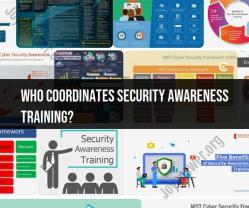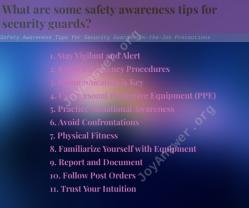Who coordinates security awareness training?
Coordinating security awareness training is typically a responsibility that falls under the purview of an organization's Information Security or Cybersecurity team. The exact role and responsibilities may vary depending on the size and structure of the organization, but here are key responsibilities and roles involved in coordinating security awareness training:
Chief Information Security Officer (CISO):
- The CISO is often responsible for overseeing the organization's entire cybersecurity program, including security awareness training. They provide strategic direction, ensure alignment with business goals, and may approve budgets for training initiatives.
Information Security Manager or Director:
- This individual manages the day-to-day operations of the information security program, which includes coordinating security awareness training. They may work closely with other departments and teams to implement training initiatives.
Security Awareness Program Manager:
- Some organizations have a dedicated manager or coordinator responsible for planning, developing, and executing the security awareness program. This role may involve curriculum development, content creation, and tracking training progress.
Training Content Developers:
- Professionals responsible for creating training materials, including e-learning modules, videos, and written guides, are integral to the training process. They ensure that training content is engaging, informative, and relevant.
IT and Security Teams:
- IT and security personnel play a vital role in supporting security awareness training efforts. They may assist in technical aspects, such as configuring security tools, conducting simulations, and responding to security incidents during training exercises.
Human Resources (HR) Department:
- HR often collaborates with the cybersecurity team to ensure that security training is integrated into the onboarding process for new employees and that employees receive ongoing training as part of their professional development.
Communication Specialists:
- Effective communication is crucial in promoting security awareness. Communication specialists may be involved in crafting messages, newsletters, and announcements related to training activities.
End Users and Employees:
- The success of security awareness training ultimately depends on the active participation of end users and employees. They are responsible for engaging in training, asking questions, and reporting security concerns.
External Training Providers:
- In some cases, organizations may partner with external training providers or cybersecurity consultants to deliver specialized training content or conduct security assessments.
Compliance and Legal Teams:
- In industries with specific regulatory requirements, compliance and legal teams may ensure that security awareness training aligns with legal and regulatory obligations.
Monitoring and Evaluation Teams:
- Personnel responsible for tracking and evaluating the effectiveness of security awareness training play a critical role in assessing whether training initiatives are achieving their intended goals.
Budget and Resource Managers:
- Individuals responsible for budget allocation and resource management ensure that the necessary financial resources are available for training initiatives.
The coordination of security awareness training is a collaborative effort that involves multiple departments and individuals within an organization. It requires a holistic approach to address the human element of cybersecurity and reduce security risks.





